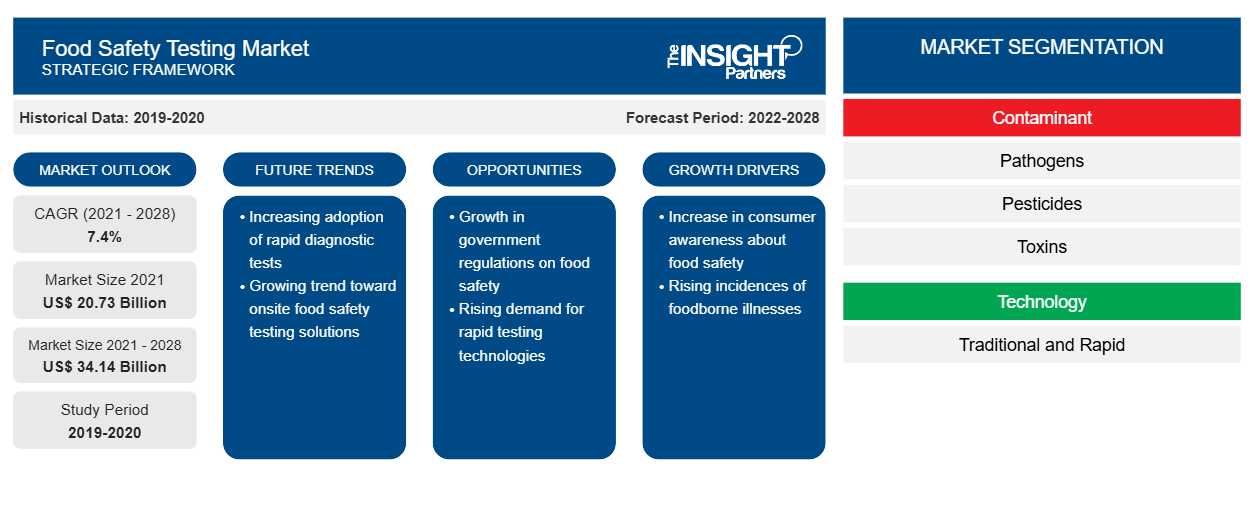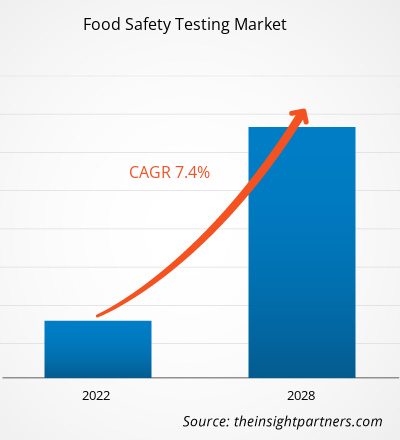食品安全検査市場は2021年に207億3,340万米ドルと評価され、2028年までに341億4,250万米ドルに達すると予測されており、2021年から2028年にかけて7.4%のCAGRで成長すると予想されています。
食品安全試験は、食品およびその内容物を科学的に分析し、物理化学的性質、組成、構造などのさまざまな特性に関する情報を見つけることです。この情報は、製品の消費の安全性を判断するために使用されます。食中毒の蔓延により、健康被害を防ぐためにすべての食品および飲料製品に対する食品安全試験が必要となり、食品安全試験市場の成長が促進されています。
世界保健機関(WHO)が発表したデータによると、安全でない食品の摂取により、毎年世界中で42万人が死亡し、6億人が食中毒にかかっています。食中毒は予防可能です。そのため、多くの組織や政府が協調行動をとっており、複数の業界にわたって回復力のある堅牢な食品安全システムを構築しています。さらに、2018年の世界銀行の報告書では、食中毒による生産性の完全な損失による経済的負担は、年間952億米ドルと推定されています。したがって、食品安全に関する消費者の意識と食中毒を防ぐための政府の取り組みにより、食品安全試験市場は成長を遂げています。
要件に合わせてレポートをカスタマイズする
このレポートの一部、国レベルの分析、Excelデータパックなど、あらゆるレポートを無料でカスタマイズできます。また、スタートアップや大学向けのお得なオファーや割引もご利用いただけます。
- このレポートの主要な市場動向を入手してください。この無料サンプルには、市場動向から見積もりや予測に至るまでのデータ分析が含まれます。
COVID-19パンデミックが食品安全検査市場に与える影響
消費者の意識は、世界中の食品安全検査市場の主要な推進力の1つです。COVID-19の発生は、消費者と政府が消費を目的とした製品の安全性と衛生に重点を置いているため、市場にプラスの影響を与えました。SARS-CoV-2は感染力が強く、食品の表面を介して移動する可能性があるため、すべての食品および飲料セクターは発生中に課題に直面しています。肉および鶏肉加工施設は、世界中のいくつかの施設の労働者が感染したため、ウイルス感染に関して独特の課題に直面しました。たとえば、米国保健福祉省は2020年7月に、23州の239の施設がCOVID-19感染の対象になったと報告しました。報告された症例の総数は16,233件で、関連死は86件でした。さらに、2020年11月、中国は、中国に輸入された冷凍豚足のサンプルが国内で新たなCOVID-19症例を引き起こしたと報告しました。食品業界におけるこのようなCOVID-19感染事例は消費者や政府に不安を引き起こし、健康リスクを軽減するための食品安全性検査の需要を促進しました。
市場分析
食中毒の発生
食中毒は有毒または感染性です。汚染された水や食品を通じて体内に入る化学物質、寄生虫、ウイルスによって引き起こされる可能性があります。食中毒の病原体は、髄膜炎や重度の下痢などの衰弱性感染症を引き起こす可能性があります。場合によっては、化学汚染が癌などの長期疾患、または急性中毒などの短期疾患を引き起こす可能性があります。安全でない食品の例としては、海洋生物毒素を含む生の貝類、排泄物で汚染された野菜や果物、動物由来の生食品などがあります。大腸菌、カンピロバクター、サルモネラは最も一般的な食中毒病原体であり、毎年世界中で何百万人もの人々を悩ませ、致命的または深刻な結果をもたらします。食中毒の症状には、下痢、腹痛、嘔吐、吐き気、頭痛、発熱などがあります。さらに、リステリア感染は新生児の死亡や妊婦の流産につながります。この病気の発生確率は比較的低いものの、リステリア菌の致死率は最も深刻な食中毒の 1 つとなっています。コレラ菌は汚染された食品や水を介して人に感染します。症状には重度の脱水症状、大量の水様性下痢、嘔吐、腹痛などがあり、死に至る可能性もあります。さまざまな種類の魚介類、雑穀粥、野菜、米がコレラの発生に関係しています。そのため、食中毒の発生を防ぐため、食品の安全性検査の需要が高まっています。
汚染物質に関する洞察
汚染物質に基づいて、食品安全検査市場は病原体、農薬、毒素、GMO、その他に分類されます。病原体セグメントは2020年に最大の市場シェアを占め、GMOセグメントは予測期間中に市場で最高のCAGRを記録すると予想されています。病原体検査は、食中毒の発生を排除または削減するために行われます。排除は非常に重要であると考えられているため、食品の安全性と衛生を確保するために、食品生産のまさにその段階で検査プロセスが実施されます。食中毒を引き起こす可能性のある最も一般的な病原体には、大腸菌、リステリア菌、サルモネラ菌などがあります。病原体検査は、従来の技術または新しい技術を使用して行うことができます。従来の技術では従来の細胞培養基準を使用しますが、新しい技術にはレーザーベースまたは分光診断が含まれます。病原体は食中毒の最も一般的な原因の1つであるため、病原体セグメントは食品安全検査市場で最大の市場シェアを占めています。また、食品・飲料業界の成長により、このセグメントの市場は予測期間中に成長すると予想されます。
テクノロジーインサイト
技術に基づいて、食品安全検査市場は、従来型と迅速型の2つに分かれています。迅速型セグメントは2020年に大きな市場シェアを占め、予測期間中に同じセグメントが市場でより高いCAGRを記録すると予想されています。主要な市場プレーヤーは、サービスの需要が高いため、迅速検査で革新的な製品を導入しています。たとえば、2009年にbioMérieux, Inc.は、食品中の微生物を列挙するための自動システムであるTEMPOを導入しました。この自動システムは、ミニチュアカードを使用した最確数(MPN)法に伴う面倒な手動手順を排除します。したがって、自動テストはシンプルなトレーサビリティと高いスループットを提供し、手動テストに代わる費用対効果の高い方法でもあります。さらに、同社は食品媒介病原体の検出に使用される組換えバクテリオファージ技術も導入しており、これにより細菌を検出可能なレベルで増殖させる時間が短縮されました。このような迅速検査は、在庫バッチの待機期間が大幅に短縮されるため、食品メーカーのコスト削減に役立ちます。したがって、迅速な検査のさまざまな利点により、予測期間中にこのセグメントの市場成長が促進されると予想されます。
食品の種類に関する洞察
食品の種類に基づいて、食品安全検査市場は、肉、鶏肉、魚介類製品、乳製品、シリアルと穀物、加工食品、果物と野菜、その他に分類されます。肉、鶏肉、魚介類製品セグメントは2020年に最大の市場シェアを占め、果物と野菜セグメントは予測期間中に市場で最高のCAGRを記録すると予想されています。肉、鶏肉、魚介類製品の検査には、汚染物質の検査と、ある種類の肉が他の種類の肉で混ぜられている食品の偽和の検査が含まれます。製品は、灰分、脂肪、水分、タンパク質/窒素、重金属、農薬、抗生物質と薬物、塩、塩化物、硝酸塩と亜硝酸塩について検査される場合があります。肉製品は、保存期間と製品の特性を考えると、汚染または欠陥が発生する可能性が最も高くなります。したがって、これらの製品の検査はすべての国で義務付けられています。この分野の市場は、世界中で肉、鶏肉、魚介類製品の消費量が増加しているため、成長すると予想されています。
食品安全試験市場で活動している企業としては、SGS SA、Eurofins Scientific、Intertek Group Plc、TÜV SÜD、AES Laboratories Pvt. Ltd.、TÜV NORD GROUP、Bureau Veritas、ALS Limited、NEOGEN Corporation、AsureQuality などがあります。これらの企業は、市場に幅広い製品ポートフォリオを提供しています。これらの企業は発展途上地域に拠点を置いており、食品安全試験市場の成長に有利な機会を提供しています。市場プレーヤーは、顧客の要件を満たす高品質で革新的な製品を開発しています。
レポートの注目点
- 食品安全検査市場における進歩的な業界動向は、プレーヤーが効果的な長期戦略を策定するのに役立ちます。
- 先進国市場と発展途上国市場で採用されているビジネス成長戦略
- 2019年から2028年までの食品安全検査市場の定量分析
- 食品安全検査の世界的需要の推定
- 業界で活動するバイヤーとサプライヤーの有効性を示すポーターの5つの力の分析
- 競争市場の状況を理解するための最近の動向
- 食品安全検査市場の成長を牽引・抑制する要因と市場動向、展望
- 商業的利益の基盤となる市場戦略を強調し、市場の成長につながる意思決定プロセスを支援する
- さまざまなノードにおける食品安全検査市場規模
- 市場の詳細な概要とセグメンテーション、および食品安全検査業界の動向
- 有望な成長機会があるさまざまな地域の食品安全検査市場の規模
食品安全検査市場の地域別洞察
予測期間を通じて食品安全試験市場に影響を与える地域的な傾向と要因は、Insight Partners のアナリストによって徹底的に説明されています。このセクションでは、北米、ヨーロッパ、アジア太平洋、中東およびアフリカ、南米および中米にわたる食品安全試験市場のセグメントと地理についても説明します。

- 食品安全検査市場の地域別データを入手
食品安全試験市場レポートの範囲
| レポート属性 | 詳細 |
|---|---|
| 2021年の市場規模 | 207.3億米ドル |
| 2028年までの市場規模 | 341.4億米ドル |
| 世界のCAGR(2021年~2028年) | 7.4% |
| 履歴データ | 2019-2020 |
| 予測期間 | 2022-2028 |
| 対象セグメント | 汚染物質別
|
| 対象地域と国 | 北米
|
| 市場リーダーと主要企業プロフィール |
|
食品安全試験市場のプレーヤー密度:ビジネスダイナミクスへの影響を理解する
食品安全試験市場は、消費者の嗜好の変化、技術の進歩、製品の利点に対する認識の高まりなどの要因により、エンドユーザーの需要が高まり、急速に成長しています。需要が高まるにつれて、企業は提供内容を拡大し、消費者のニーズを満たすために革新し、新たなトレンドを活用し、市場の成長をさらに促進しています。
市場プレーヤー密度とは、特定の市場または業界内で活動している企業または会社の分布を指します。これは、特定の市場スペースに、その市場規模または総市場価値に対してどれだけの競合相手 (市場プレーヤー) が存在するかを示します。
食品安全検査市場で事業を展開している主要企業は次のとおりです。
- SGS SA
- ユーロフィンサイエンティフィック
- インターテックグループ
- テュフズード
- AES ラボラトリーズ株式会社
免責事項:上記の企業は、特定の順序でランク付けされていません。

- 食品安全検査市場のトップキープレーヤーの概要を入手
食品安全検査市場 – 汚染物質別
- 病原体
- サルモネラ
- 大腸菌
- リステリア
- その他
- 農薬
- 毒素
- 遺伝子組み換え作物
- その他
食品安全検査市場 – 技術別
- 伝統的
- 急速な
- PCR検査
- 免疫測定法による検査
- その他
食品安全検査市場 – 食品の種類別
- 肉類、鶏肉、魚介類
- 乳製品
- 穀物
- 加工食品
- 果物と野菜
- その他
企業プロフィール
- SGS SA
- ユーロフィンサイエンティフィック
- インターテックグループ
- テュフズード
- AES ラボラトリーズ株式会社
- TÜV NORD グループ。
- ビューローベリタス
- ALSリミテッド
- ネオジェン株式会社
- アシュアクオリティ
- 過去2年間の分析、基準年、CAGRによる予測(7年間)
- PEST分析とSWOT分析
- 市場規模価値/数量 - 世界、地域、国
- 業界と競争環境
- Excel データセット



Report Coverage
Revenue forecast, Company Analysis, Industry landscape, Growth factors, and Trends

Segment Covered
This text is related
to segments covered.

Regional Scope
North America, Europe, Asia Pacific, Middle East & Africa, South & Central America

Country Scope
This text is related
to country scope.
よくある質問
Based on technology, the food safety testing market is bifurcated into traditional and rapid. The rapid segment accounted for a larger market share in 2020. Rapid tests prove to be useful in terms of cost saving for food manufacturers as the waiting period for batches in inventory is significantly reduced. Thus, the multiple benefits of rapid testing is expected to fuel the market growth for this segment during the forecast period.
In 2020, China held the largest market share in the global food safety testing market. China is the most populated country in the world and is a major hub for food and beverages industry. The country annually imports and exports large quantities of food products to different parts of the world. As per data published by the International Trade Administration, U.S. Department of Commerce, the food and beverage sector of China reached US$ 595 billion in 2019 in terms of consumption. Moreover, considering the aggressive development of China and rising middle class population with high disposable income, numerous food brands are attempting to enter the market in the country. Therefore, the food trade as well as consumption in the country is growing at a high pace resulting in positive impact for food safety testing, as testing in the country is becoming increasingly stringent for food processing.
The pathogens segment accounted for the largest market share in 2020. Since pathogens are one of the most common reasons for foodborne illnesses, the pathogen segment holds the largest market share in the food safety testing market. Also, the market for this segment is expected to grow at a high pace during the forecast period due to the growth of the food & beverages industry.
The major players operating in the global food safety testing market are SGS SA, Eurofins Scientific, Intertek Group Plc, TÃœV SÃœD, AES Laboratories Pvt. Ltd., TÃœV NORD GROUP., Bureau Veritas, ALS Limited, NEOGEN Corporation, and AsureQuality.
Foodborne illnesses are toxic or infectious. They can be caused by the chemical substances, parasites, viruses entering the body through contaminated water or food. In some cases chemical contamination can cause long-term diseases, such as cancer, or short-term illness, such as acute poisoning. A few examples of unsafe food are raw shellfish containing marine biotoxins, vegetables and fruits contaminated with feces, and uncooked foods of animal origin. E. Coli, campylobacter, and salmonella are among the most common foodborne pathogens that affect millions of people worldwide annually and result in fatal or severe outcomes. Moreover, listeria infection leads to death of newborn babies or miscarriages in pregnant women. Although the chances of this disease are relatively low, the fatality of listeria makes it one of the most serious foodborne infections. Vibrio cholera infects people through contaminated food or water. Various types of seafood, millet gruel, vegetables, and rice have been implicated in cholera outbreaks. Therefore, the demand for food safety testing is increasing to prevent the incidence of foodborne illnesses.
In 2020, North America held the largest share of the market. The Centre for Disease Control and Prevention (CDC) has determined that one out of ten people fall sick due to foodborne illness each year in the US. The rising incidence of foodborne diseases has propelled the need for rapid testing, which is driving the market growth in North America. Additionally, enhanced detection and surveillance methods have fueled the food safety testing market growth in North America.
Trends and growth analysis reports related to Consumer Goods : READ MORE..
The List of Companies - Food Safety Testing Market
- SGS SA
- Eurofins Scientific
- INTERTEK GROUP PLC
- TÜV SÜD
- AES Laboratories Pvt. Ltd.
- TÜV NORD GROUP.
- BUREAU VERITAS
- ALS Limited
- NEOGEN Corporation
- AsureQuality
The Insight Partners performs research in 4 major stages: Data Collection & Secondary Research, Primary Research, Data Analysis and Data Triangulation & Final Review.
- Data Collection and Secondary Research:
As a market research and consulting firm operating from a decade, we have published and advised several client across the globe. First step for any study will start with an assessment of currently available data and insights from existing reports. Further, historical and current market information is collected from Investor Presentations, Annual Reports, SEC Filings, etc., and other information related to company’s performance and market positioning are gathered from Paid Databases (Factiva, Hoovers, and Reuters) and various other publications available in public domain.
Several associations trade associates, technical forums, institutes, societies and organization are accessed to gain technical as well as market related insights through their publications such as research papers, blogs and press releases related to the studies are referred to get cues about the market. Further, white papers, journals, magazines, and other news articles published in last 3 years are scrutinized and analyzed to understand the current market trends.
- Primary Research:
The primarily interview analysis comprise of data obtained from industry participants interview and answers to survey questions gathered by in-house primary team.
For primary research, interviews are conducted with industry experts/CEOs/Marketing Managers/VPs/Subject Matter Experts from both demand and supply side to get a 360-degree view of the market. The primary team conducts several interviews based on the complexity of the markets to understand the various market trends and dynamics which makes research more credible and precise.
A typical research interview fulfils the following functions:
- Provides first-hand information on the market size, market trends, growth trends, competitive landscape, and outlook
- Validates and strengthens in-house secondary research findings
- Develops the analysis team’s expertise and market understanding
Primary research involves email interactions and telephone interviews for each market, category, segment, and sub-segment across geographies. The participants who typically take part in such a process include, but are not limited to:
- Industry participants: VPs, business development managers, market intelligence managers and national sales managers
- Outside experts: Valuation experts, research analysts and key opinion leaders specializing in the electronics and semiconductor industry.
Below is the breakup of our primary respondents by company, designation, and region:

Once we receive the confirmation from primary research sources or primary respondents, we finalize the base year market estimation and forecast the data as per the macroeconomic and microeconomic factors assessed during data collection.
- Data Analysis:
Once data is validated through both secondary as well as primary respondents, we finalize the market estimations by hypothesis formulation and factor analysis at regional and country level.
- Macro-Economic Factor Analysis:
We analyse macroeconomic indicators such the gross domestic product (GDP), increase in the demand for goods and services across industries, technological advancement, regional economic growth, governmental policies, the influence of COVID-19, PEST analysis, and other aspects. This analysis aids in setting benchmarks for various nations/regions and approximating market splits. Additionally, the general trend of the aforementioned components aid in determining the market's development possibilities.
- Country Level Data:
Various factors that are especially aligned to the country are taken into account to determine the market size for a certain area and country, including the presence of vendors, such as headquarters and offices, the country's GDP, demand patterns, and industry growth. To comprehend the market dynamics for the nation, a number of growth variables, inhibitors, application areas, and current market trends are researched. The aforementioned elements aid in determining the country's overall market's growth potential.
- Company Profile:
The “Table of Contents” is formulated by listing and analyzing more than 25 - 30 companies operating in the market ecosystem across geographies. However, we profile only 10 companies as a standard practice in our syndicate reports. These 10 companies comprise leading, emerging, and regional players. Nonetheless, our analysis is not restricted to the 10 listed companies, we also analyze other companies present in the market to develop a holistic view and understand the prevailing trends. The “Company Profiles” section in the report covers key facts, business description, products & services, financial information, SWOT analysis, and key developments. The financial information presented is extracted from the annual reports and official documents of the publicly listed companies. Upon collecting the information for the sections of respective companies, we verify them via various primary sources and then compile the data in respective company profiles. The company level information helps us in deriving the base number as well as in forecasting the market size.
- Developing Base Number:
Aggregation of sales statistics (2020-2022) and macro-economic factor, and other secondary and primary research insights are utilized to arrive at base number and related market shares for 2022. The data gaps are identified in this step and relevant market data is analyzed, collected from paid primary interviews or databases. On finalizing the base year market size, forecasts are developed on the basis of macro-economic, industry and market growth factors and company level analysis.
- Data Triangulation and Final Review:
The market findings and base year market size calculations are validated from supply as well as demand side. Demand side validations are based on macro-economic factor analysis and benchmarks for respective regions and countries. In case of supply side validations, revenues of major companies are estimated (in case not available) based on industry benchmark, approximate number of employees, product portfolio, and primary interviews revenues are gathered. Further revenue from target product/service segment is assessed to avoid overshooting of market statistics. In case of heavy deviations between supply and demand side values, all thes steps are repeated to achieve synchronization.
We follow an iterative model, wherein we share our research findings with Subject Matter Experts (SME’s) and Key Opinion Leaders (KOLs) until consensus view of the market is not formulated – this model negates any drastic deviation in the opinions of experts. Only validated and universally acceptable research findings are quoted in our reports.
We have important check points that we use to validate our research findings – which we call – data triangulation, where we validate the information, we generate from secondary sources with primary interviews and then we re-validate with our internal data bases and Subject matter experts. This comprehensive model enables us to deliver high quality, reliable data in shortest possible time.


 このレポートの無料サンプルを入手する
このレポートの無料サンプルを入手する